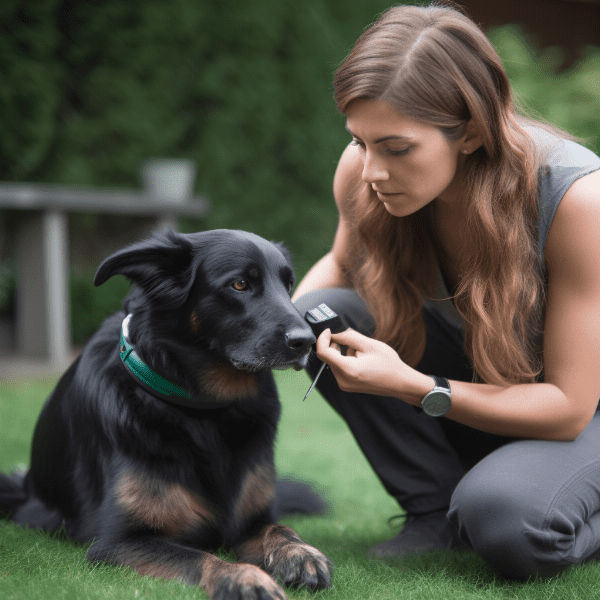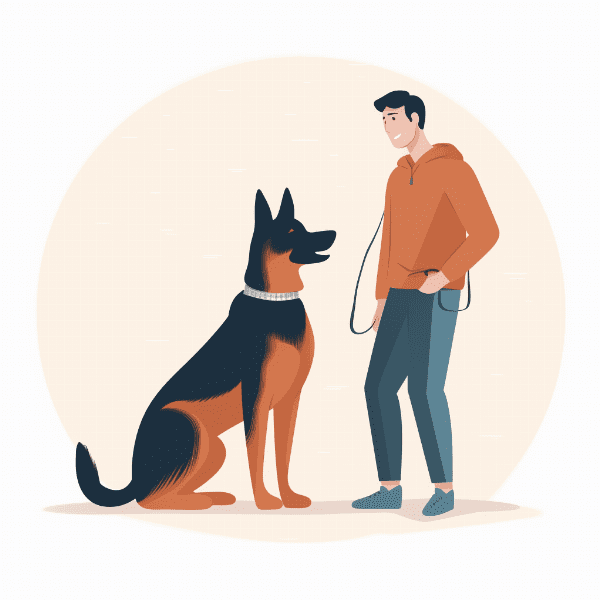Table of Contents
- Understanding Why Dogs Bark at Nothing
- Identifying Triggers for Unnecessary Barking
- Training Techniques for Reducing Barking
- Consistency and Reinforcement in Training
- Positive Reinforcement Methods for Quieting Your Dog
- Addressing Underlying Anxiety or Behavioral Issues
- Creating a Calm Environment for Your Dog
- Using Tools and Devices to Stop Barking
- Seeking Professional Help for Persistent Barking
- Maintaining Progress and Celebrating Success
Understanding Why Dogs Bark at Nothing
Dogs bark as a way of communicating with their owners and the world around them. While barking is a normal behavior for dogs, barking at nothing can be frustrating and confusing for owners. So, why do dogs bark at nothing?
1. Territorial Behavior
Dogs are territorial animals, and they can bark at any perceived threat to their territory. Even when there is nothing to bark at, your dog may bark to protect their home and their family. This behavior can become a problem when your dog barks excessively or at inappropriate times.
2. Attention-Seeking Behavior
Dogs love attention and will bark to get it. If your dog is barking at nothing, they may be trying to get your attention or seeking interaction. They may also be bored and looking for something to do.
3. Separation Anxiety
Dogs that suffer from separation anxiety may bark when left alone or when they are feeling anxious. This barking can be triggered by the absence of their owner or the anticipation of being left alone.
4. Medical Issues
Sometimes, dogs that bark at nothing may be experiencing pain or discomfort. This behavior can be a sign of a medical issue, such as an injury or illness. It’s important to rule out any underlying medical problems if your dog is barking excessively.
5. Lack of Socialization
Dogs that have not been properly socialized may be more prone to barking at nothing. They may be fearful of new experiences or people, and their barking can be a defense mechanism.
Understanding the reasons behind your dog’s barking can help you address the behavior and find a solution. By identifying the underlying cause, you can begin to implement training and behavioral techniques to help reduce barking and create a happier, healthier relationship with your furry friend.

Identifying Triggers for Unnecessary Barking
To stop your dog from barking at nothing, you must first identify the triggers for the behavior. Here are some potential triggers to consider:
1. Environmental Triggers
Environmental triggers, such as loud noises or unfamiliar scents, can cause your dog to bark. Pay attention to your dog’s behavior and try to identify any patterns in their barking. If your dog barks at the sound of thunder or a passing car, for example, you can take steps to minimize their exposure to those triggers.
2. Separation Anxiety
As mentioned earlier, separation anxiety can cause dogs to bark excessively. If your dog barks when you leave the house or is destructive when you are gone, they may be suffering from separation anxiety. Consider working with a professional dog trainer or behaviorist to address this issue.
3. Lack of Exercise or Stimulation
Dogs that are bored or lacking exercise may bark to release pent-up energy. Make sure your dog is getting enough exercise and mental stimulation each day. This can include walks, playtime, and puzzle toys.
4. Attention-Seeking Behavior
If your dog barks for attention, it’s important not to reward the behavior. Avoid giving your dog attention when they are barking, even if it’s negative attention like scolding. Instead, reward your dog when they are quiet and calm.
5. Medical Issues
As previously mentioned, medical issues can also cause dogs to bark excessively. If you’ve ruled out other potential triggers and your dog’s barking persists, it may be time to take them to the vet for a check-up.
Identifying the triggers for your dog’s barking can help you determine the best approach for addressing the behavior. By understanding what causes your dog to bark, you can work to minimize their exposure to those triggers and implement training and behavior modification techniques to create a quieter, more peaceful household.

Training Techniques for Reducing Barking
Now that you’ve identified the triggers for your dog’s unnecessary barking, it’s time to implement some training techniques to reduce the behavior. Here are some effective methods for training your dog to bark less:
1. Teach the “Quiet” Command
Teaching your dog the “quiet” command is a great way to help them understand when barking is and isn’t acceptable. Begin by saying “speak” or another command that your dog associates with barking. Once your dog starts barking, say “quiet” and offer them a treat when they stop barking. Repeat this process until your dog understands the command.
3. Ignore Unnecessary Barking
If your dog is barking for attention or out of boredom, ignoring the behavior can be an effective way to reduce it. Avoid giving your dog attention when they are barking and only offer attention and rewards when they are calm and quiet.
4. Provide Mental Stimulation
Providing your dog with mental stimulation, such as puzzle toys or training exercises, can help reduce their need to bark. These activities can help occupy your dog’s mind and provide an outlet for their energy.
5. Be Consistent
Consistency is key when it comes to training your dog to bark less. Make sure that all members of your household are on the same page and are using the same commands and techniques to train your dog. This will help reinforce the desired behavior and make it more likely to stick.
By using these training techniques consistently, you can help reduce your dog’s unnecessary barking and create a happier, healthier relationship with your furry friend. Remember to be patient and consistent, as training takes time and effort.

Consistency and Reinforcement in Training
Training your dog to bark less requires consistency and reinforcement. Here are some tips to help you stay on track:
1. Set Clear Expectations
Before you begin training your dog, make sure you have a clear idea of what behaviors you want to encourage and discourage. This will help you stay consistent in your training approach.
3. Be Patient
Training takes time, and it’s important to be patient with your dog. Avoid getting frustrated if they don’t pick up on a command or behavior right away. Consistency and repetition are key to success.
4. Avoid Punishment
Punishing your dog for barking may seem like an effective way to stop the behavior, but it can actually make the behavior worse. Avoid scolding or punishing your dog when they bark and instead focus on positive reinforcement techniques.
5. Practice Regularly
Consistency is key to successful training. Make sure to practice training techniques regularly, even when your dog isn’t barking. This will help reinforce the desired behaviors and make them more likely to stick.
6. Get Everyone on the Same Page
Consistency is important not only for you but for everyone in your household. Make sure that all family members are on the same page when it comes to training techniques and expectations for your dog’s behavior.
By staying consistent and using positive reinforcement techniques, you can effectively train your dog to bark less. Remember to be patient and avoid punishment, as this can make the behavior worse. With time and effort, you can create a peaceful and happy home for both you and your furry friend.

Positive Reinforcement Methods for Quieting Your Dog
Using positive reinforcement techniques is an effective way to train your dog to bark less. Here are some positive reinforcement methods you can use to quiet your dog:
1. Treats and Toys
Offering your dog treats or toys when they are quiet is a great way to reinforce the behavior. Make sure to only offer the reward when your dog is quiet, and not when they are barking.
2. Clicker Training
Clicker training is a form of positive reinforcement training that uses a clicker to mark desired behaviors. When your dog exhibits the desired behavior, click the clicker and offer them a treat or praise. This will help them understand what behaviors you want them to exhibit.
3. Verbal Praise
Offering verbal praise when your dog is quiet is a simple yet effective way to reinforce the behavior. Use phrases like “good quiet” or “quiet dog” to let your dog know that they are exhibiting the desired behavior.
4. Massage and Petting
Dogs love physical affection, and offering your dog a massage or petting when they are quiet is a great way to reinforce the behavior. This will help your dog associate being quiet with positive physical contact.
5. Timeouts
Sometimes, giving your dog a timeout in a quiet area can be an effective way to reduce barking. When your dog starts barking, calmly remove them from the situation and place them in a quiet room or crate. Once they have calmed down, offer them verbal praise and physical affection.
Using positive reinforcement methods consistently can help train your dog to bark less and create a more peaceful household. Remember to only offer rewards when your dog is quiet, and avoid punishing or scolding your dog when they are barking. With time and effort, you can create a happy and well-trained furry friend.

Addressing Underlying Anxiety or Behavioral Issues
In some cases, excessive barking can be a sign of underlying anxiety or behavioral issues. Here are some strategies for addressing these issues:
1. Identify the Underlying Issue
Before you can address anxiety or behavioral issues, it’s important to identify the root cause of the behavior. Common issues that can lead to excessive barking include separation anxiety, fear, and aggression.
2. Work with a Professional
If your dog’s barking is caused by anxiety or behavioral issues, consider working with a professional dog trainer or behaviorist. They can help you develop a customized training plan to address the underlying issue.
3. Create a Calming Environment
Creating a calming environment for your dog can also help reduce anxiety and excessive barking. This can include providing a comfortable and quiet space for your dog to retreat to, as well as using calming scents or music to help them relax.
.

Creating a Calm Environment for Your Dog
Creating a calm environment for your dog is an important part of reducing excessive barking. Here are some tips for creating a peaceful and relaxing environment for your furry friend:
1. Provide a Comfortable and Quiet Space
Make sure your dog has a comfortable and quiet space to retreat to when they need to relax. This could be a cozy bed in a quiet corner of the room or a crate in a secluded area.
2. Use Calming Scents
Calming scents, such as lavender or chamomile, can help relax your dog and reduce anxiety. Consider using a diffuser or spray to distribute the scent throughout your home.
3. Play Relaxing Music
Playing relaxing music, such as classical or nature sounds, can also help calm your dog and reduce barking. Experiment with different types of music to find what your dog responds to best.
4. Keep a Consistent Routine
Dogs thrive on routine and consistency. Make sure to establish a consistent routine for feeding, exercise, and training. This will help your dog feel more secure and less anxious.
5. Minimize Exposure to Triggers
As mentioned earlier, identifying triggers for unnecessary barking is an important part of reducing the behavior. Once you’ve identified triggers, take steps to minimize your dog’s exposure to them. This may include closing the curtains during thunderstorms or avoiding noisy areas during walks.
By creating a calm environment for your dog, you can help reduce anxiety and excessive barking. Remember to be patient and consistent in your efforts, and consider working with a professional if your dog’s behavior persists. With time and effort, you can create a happier and more peaceful home for both you and your furry friend.

Using Tools and Devices to Stop Barking
In addition to training and behavior modification techniques, there are also tools and devices that can help stop excessive barking. Here are some options to consider:
2. Citronella Collars
Citronella collars work by emitting a burst of citronella spray when your dog barks. The scent of the citronella is unpleasant to most dogs, which can help deter barking behavior.
3. Ultrasonic Devices
Ultrasonic devices emit a high-pitched sound that is only audible to dogs. These devices can be effective in stopping excessive barking, but it’s important to use them correctly and avoid overuse or abuse.
4. Muzzles
Muzzles are another option to consider for dogs that bark excessively. A muzzle can help prevent your dog from barking, but it’s important to use the correct type of muzzle and only use it when necessary.
5. Automatic Treat Dispensers
Automatic treat dispensers can be used as a positive reinforcement tool to encourage quiet behavior. When your dog is quiet, the dispenser will release a treat. This can help train your dog to associate being quiet with positive rewards.
It’s important to remember that tools and devices should not be used as a substitute for training and behavior modification techniques. When used correctly and in conjunction with positive reinforcement, these tools can be effective in stopping excessive barking. However, it’s important to use them correctly and avoid overuse or abuse. Consult with a professional dog trainer or behaviorist before using any tools or devices to stop barking.

Seeking Professional Help for Persistent Barking
If your dog’s excessive barking persists despite your best efforts, it may be time to seek professional help. Here are some options to consider:
1. Consult with a Veterinarian
Your veterinarian can help rule out any underlying medical issues that may be causing your dog’s excessive barking. They can also provide guidance on behavior modification techniques and recommend a professional dog trainer or behaviorist.
2. Work with a Professional Dog Trainer
A professional dog trainer can help develop a customized training plan to address your dog’s excessive barking. They can provide guidance on positive reinforcement techniques and help you stay consistent in your training efforts.
3. Consult with a Professional Behaviorist
If your dog’s excessive barking is caused by anxiety or other behavioral issues, a professional behaviorist can provide specialized guidance and support. They can work with you to develop a behavior modification plan tailored to your dog’s specific needs.
4. Consider Medication
In some cases, medication may be necessary to address underlying anxiety or behavioral issues. Your vet or a professional behaviorist can help determine if medication is necessary and what type of medication may be best for your dog.
5. Be Patient and Consistent
Remember that addressing excessive barking takes time and effort. It’s important to be patient and consistent in your training and behavior modification efforts. Avoid punishment or scolding, and focus on positive reinforcement techniques.
By seeking professional help and staying patient and consistent in your efforts, you can effectively address your dog’s excessive barking and create a happier, healthier relationship with your furry friend.

Maintaining Progress and Celebrating Success
Reducing your dog’s excessive barking is an ongoing process that requires patience, consistency, and dedication. Here are some tips for maintaining progress and celebrating success:
1. Stay Consistent
Consistency is key to maintaining progress in reducing excessive barking. Make sure to stick to your training and behavior modification plan, and avoid deviating from it.
2. Use Positive Reinforcement
Positive reinforcement is a powerful tool in maintaining progress. Continue to offer verbal praise, treats, and physical affection when your dog exhibits the desired behavior.
3. Monitor Triggers
Keep an eye out for triggers that may cause your dog to bark excessively. If a trigger is identified, take steps to minimize your dog’s exposure to it.
4. Celebrate Success
Celebrating success is an important part of maintaining progress. When your dog exhibits less barking behavior, take the time to praise and reward them. This will reinforce the desired behavior and motivate you to continue your efforts.
5. Be Patient
Reducing excessive barking takes time and effort. Remember to be patient with your dog and yourself, and avoid getting frustrated if progress is slow.
By staying consistent, using positive reinforcement, monitoring triggers, celebrating success, and being patient, you can maintain progress in reducing your dog’s excessive barking. Remember to seek professional help if necessary and continue to work on creating a happy and peaceful relationship with your furry friend.




